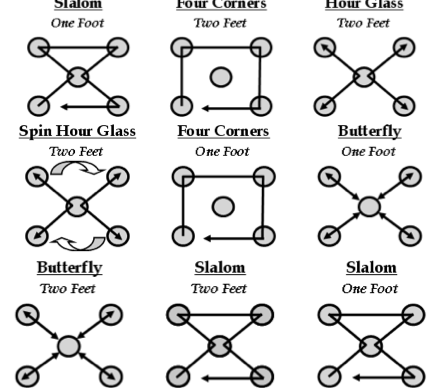
INVERSION ANKLE SPRAIN
Carley Maanika, ATS
Kelley Galloway, ATS
Jessica Krali, ATS
Northern Michigan University
Pathology, Diagnosis, and Getting On Track with Rehabilitation
LATE STAGES OF REHABILITATION
The maturation/remodeling phase is the third phase in the healing process. This is the longest phase of the healing process and can last anywhere from three weeks to several months to several years, depending on the patient's compliance and injury severity. During this phase, collagen fibers continue to synthesis and the increase stresses and strains of physical activity allows for an increase in the realignment of the collagen fibers. The implications of this is described in Wolff’s law, which states that bone and soft tissue will respond to the physical demands placed on them, causing them to remodel or realign along the lines of the tensile force. Therefore, the collagen fibers will align with the line of tension for maximum efficiency. Heating is beneficially in this phase to loosen the collagen fibers, reduce pain, and increase blood flow (Prentice, 2011).
Structural Integrity, pain-free range of motion, pain free weight bearing/normal walking gait, and reduced inflammation and swelling should be achieved before begining this phase of rehab. Pain and return of symptoms are the two main contraindications of this phase. If pain is present during these excersises or symptoms return following activity, then the exercise should be lowered or discontinued. The early stage of the maturation remodeling phase should focus on increase strength, incorporating muscular endurance and speed, and implementing muscular power. The later stage of maturation remodling should focus on increasing muscular power, incorporating intergrated and coordinated movement, and implementing agility. Cardiovascular fitness should be met throughout this phase.
Goals of Rehabilitation at the Maturation Remodeling Phase
(2/4-6/8 weeks post-injury):
Early Stage (2-4 weeks):
-
Muscular Strength (with Core Strength)
-
Muscular Endurance
-
Muscular Speed
-
Cardiovascular Fitness (Continued)
Late Stage (4-6 weeks):
-
Muscular Power
-
Intergrated and Coordinated Movements
-
Agility
-
Cardiovascular Fitness (Continued)
Squat Jumps
Suicides - Volleyball
Modification
Begin at ten foot line. Run to net and jump as if going to block. Run back to ten-foot line and touch the line. Run to net and jump for a block. Run back to baseline and touch the line. Run to net and jump. Run to ten foot line and repeat the process 3 times.
-
Three sets across the ten-foot line .
Additional excersises with progression of Suicides Drills:
-
Suicides with Block (modified suicide with the athlete completing two blocks at the net before progressing to next set): Three sets with two blocks after each set. Can be done with teammate for added challenge in later week.
-
Suicides with Hit/Spike (modified suicide with the athlete completing a hit/spike at the net before progressing to next set): Three sets with one hit/spike after each set. Can be done with teammate for added challenge in later week.
-
Twist and Hit (have athlete stand on baseline with back to net. Throw ball and blow whistle. Athlete must turn and sprint for ball, successfully hitting it back to target.): Three sets with ten successful hits.
Agility - Dot Patterns
Modified Burpees
Begin with feet shoulder width apart and knees and hips slightly bent to about 30 degrees. Back and upper body must be straight to prevent low back injury.The patient slowly squats down while keeping back and upper body straight and core tight; keep heels on the ground, and do not allow them to raise during the squat. Add a jump as you return to beginning position from the down phase; the jump should be quick and forceful from the down phase, reaching towards the ceiling for more force.Athlete should aim to increase their height with the jump and descent with the squat. Increasing intensity is achieved by adding a weight to hold on to during the exercise, or having them wear a weighted vest.
-
Three sets, five repititions.
Additional Exercises Implemented with progression of Squat Jumps:
-
Knee Tucks (start in squat and jump, bringing knees up to chest): three sets, five jumps
-
Broad Jumps (start at line, jump as far as possible with two legs): three sets, as far as athlete can go.
-
One legged squats (peform one legged squat on both injured and uninjured legs): three sets of ten reps. Once balance is maintained peform exercise on bosu ball or unstable surface.
Lateral Lunges
Begin with feet together. Take one step to the side and sink into a squat; keep back and upper body straight, core tight and opposing leg straight. Lift yourself up and return to starting position. Repeat on opposing side. To add plyometric component, add a hop from one side to the opposing side.
-
Three sets, ten repetitions (side to side movement equals 1 rep).
-
Intensity: Movements should be quick with plyometric involvement and slow without it. Weights can be added in side to side movements. This exercise be transitioned into lateral bounds.
Additional exercises with progression of Lateral Lunges:
-
Lateral bounds (jump one leg to the other on each side): three sets, ten times each foot
-
Line jumps (double to single leg, hop over line progress to block): three sets, ten times each
-
Shuffle drills (have athlete stand on baseline, throw ball from one side of the court, have her shuffle to it and return it. Repeat to other side of the court.): Three sets, ten reps. (athlete must traverse the court from left to right and right to left once for one rep.)
Start with feet shoulder width apart. Move into a squat, placing arms between legs. Step back into a plank one foot at a time, making sure that back and legs are straight and core is tight. Step feet back into squat. Remove hands from ground, stand up with legs. Increase intensity by adding jump instead of stepping back, jump instead of a stand, or push-up while in plank form.
-
Three sets, twenty repetitions each set.
Additional excersises with progression of Burpees:
-
Digging drills (athlete lays prone on ground. Whistle and throw ball. Athlete must jump from ground and retrieve the ball, hitting it back to target): Three sets, tens successful hits.
-
Pattern One: Place five ‘dots’ on the floor, spaced 1 foot apart, with two-one-two pattern. Begin by jumping with one foot on to the first two dots with both feet. Hop with both feet into the center dot. Jump and land with one foot on each of the second set of two dots. Hop with both feet back to the center dot backwards. Jump with both feet to the first two set of dots. Repeat the process five times.
-
Pattern Two: Switch to two feet on one dot. Begin on the dot of one of the feet. Jump to the center dot, followed by the dot in the second set in line with the dot you began with. Jump to the second dot in the second set and repeat the process backwards with the remaining dots. Repeat the process five times.
-
Aim for a time lower than thirty seconds, incorporate at least three patterns and aim for two to three sets a day as tolerated by patient.
Additional exercises with progression of Dot Drills:
-
Add variations of dot drill to patterns (progress to one foot variations as tolerated by the athlete): 3 patterns completed five times, or two times apiece for single leg, in 30 seconds.
-
Dot drill followed by quick sprint to net.

Core Exercises
-
Planks (push-up position or elbow): Hold for 30 seconds, four-five sets.
-
Bridges (Supine with arms and heels on ground): 10 contractions with butt remaining about 1 inch off ground, three sets. You can increase intensity by lifting one foot and keeping it straight throughout the exercise.
-
Mountain climbers (bring foot to chest level, switch off quickly without raising butt): Three sets of 10 reps (both feet equal 1 rep)
-
Wall-sits (hip and knee flexion close to, but not below, 90 degrees): 1 minute holds for 3-4 sets.
-
Reverse Crunches (supine, bring knees and feet off ground.): Three sets, 15 reps.
Video retrieved from https://www.youtube.com/watch?v=CVaEhXotL7M
Video retrievedfrom https://www.youtube.com/watch?v=J1JwEN32nCQ
Video retrieved from http://www.youtube.com/watch?v=2SHJJpw1c84
Image retrieved from http://upload7.ir/images/46800576477310574381.png
Video retrieved from https://www.youtube.com/watch?v=ZVva3Dyul7k
-
Progress to normal running gait for 1 mile with 2/10 on pain scale.
-
Increase weight-bearing on injured leg to 80% load capacity.
-
No return of symptoms during or post injury.
-
Increase strength to 5/5 in all motions.
Cardiovascular Fitness
-
Intervals on Bike (1 high intensity to 3 low intensity): Increments should increase as the athlete progresses. Example: 15 seconds high intensity at 80% max heart rate, 45 seconds low intensity at 70% max heart rate. Next set 30 seconds high intensity at 80% max heart rate, 90 seconds low intensity at 70% max heart rate. Continue until athlete has reached one minute, then decrease by increments of 15 seconds.
-
Jogging laps around the court (progress from bike, monitoring pain level): two-three laps to begin, work towards 29 laps. (29 laps equals one mile).
-
T-Test (four cones set up in a t-formation. Player sprints to first cone, shuffles to two side cone and jogs backwards back to first.): Three sets, aim for under 15 seconds apiece.
*Additional exercises can be added or performed. No two rehabilitation plans are the same. Be sure to incorporated exercises that fit the need of the athlete.